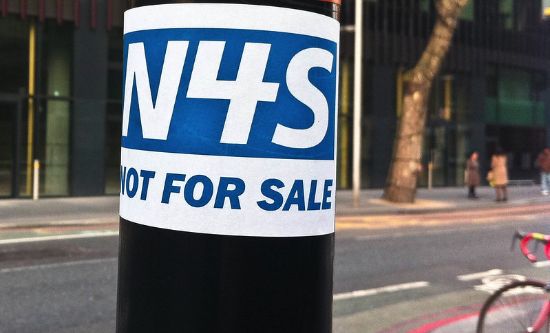
5 July this year marked the 75th anniversary of the foundation of the NHS. At the time the ruling class was concerned to ensure social stability with low wages at home while it looted the colonial empire to restore its economic position post-war. The NHS was a vital component of a settlement it reached with the working class offering the majority a more tolerable life while maintaining the system of capitalist exploitation. Decades of deepening crisis since the 1970s however have now pushed large sections of the working class into poverty or near-poverty, while NHS services have been progressively torn to shreds.
In August 2023, NHS waiting lists stood at nearly 7.7 million. As some people are on several treatment pathways, there are about 6.5 million individuals waiting for some form of NHS treatment, and this excludes the approximately half a million ‘hidden’ in queues trying to get a referral for treatment. 385,000 have been waiting for more than a year, with a 9.7% rise in the number of children waiting over a year for consultant-led care. Such waiting lists were rising long before Covid-19 and the strikes undertaken by nurses, paramedics, ambulance staff and currently, junior doctors and consultants.
October 2023 will see the seventh consecutive month of industrial action by junior doctors (any doctors in training below consultant level) and the fourth by consultants. They are members of the British Medical Association (BMA), whose membership stands at 190,366, up by over 25,000 compared to this time last year. The strikes have cost the NHS £1bn so far, a sum which could have been used to offer junior doctors the 12.4% deal they accepted in Scotland. Instead, nearly 900,000 routine operations and appointments have been postponed. The BMA says junior doctors’ pay has been cut by 26%, while the government has imposed a settlement of 8.8%. Health Secretary Steve Barclay has also imposed a 6% pay settlement on consultants; the BMA has rejected both but said it would settle for 12%.
The junior doctors have had the support of the consultants who have in the main provided emergency cover during the strikes. However, this has come at a further cost to the NHS with over 1,000 senior doctors signing a letter in June urging NHS London and trusts to pay consultants who provide strike cover the rates recommended by the BMA, which range from £161 an hour daytime to £269 an hour overnight. This is adding extra costs for hospitals but not so that it will being the government to the negotiating table. Meanwhile the government is preparing to use its new anti-trade union legislation on minimum service levels against the doctors.
Years of underfunding the NHS have led to ever more intensive working conditions for clinical staff whoever they are. The result is either exhaustion, rising sickness rates – 29% up over the last year compared to the year before the pandemic – or an increased demand for early retirement in an already-ageing workforce. The NHS is losing doctors of all ages and stages of professional development to Ireland, Australia, New Zealand and UAE, with offers of salaries three or even four times those in the NHS. A 2022 doctors’ survey of over 4,000 doctors showed that 15% are taking steps to leave medicine in Britain (up from 7% in 2021) and 25% categorised themselves as being at high risk of burnout. Young doctors feel overworked, anxious and undercompensated. A 2023 survey of 10,486 medical students in BMJ Open concluded that around one in three medical students in Britain plan to leave the NHS within two years of graduating, either leaving Britain or leaving medicine.
While the government boasts of offering more and more money to the NHS – £1bn earlier this year (2023) for its urgent care recovery plan, and now £200m to deal with winter pressures – these are pitiful sums: NHS England’s annual budget stands at £153bn and needs to grow at 4% annually in real terms to meet increased demand and the costs of new drugs and treatments. However, the growth was zero in 2021/22, negative in 2022/23, and is just 1.5% for 2023/24 and 2024/25. Such sums have ensured that the current NHS staffing shortfall of 112,000 will remain the norm for years to come. As for the NHS workforce plan finally announced this summer, the predicted numbers of extra staff – 60,000 more doctors, 170,000 more nurses, 71,000 more allied health professional in the workforce by 2036 – will need billions of extra funding, but the Treasury has only agreed to £1bn over the next five years. In the meantime, life expectancy has stalled and compares poorly with other countries: a recent study showed that the UK had the second lowest life expectancy among 19 countries analysed, with only the United States faring worse. Now, fewer than one in ten males born today are expected to reach retirement age in good health; in Blackpool life expectancy is only just over the retirement age of 67 in the poorest wards.
However, maintaining the NHS is a cost for the ruling class – it is paid for out of profits diverted to the state sector. In today’s crisis conditions this is no longer acceptable for the ruling class, and with the balance of class forces weighted against the working class unlike in 1948, it demands that the government of the day cuts this spending, and offers up whatever services can be transformed into profit-making enterprises. Labour is in complete agreement with this: Shadow Secretary for Health Wes Streeting has committed to further privatisations.
He has accepted donations of £15,000 from hedge fund boss John Armitage for ‘staffing costs’ in his office. Armitage has a stake in US private health insurance giant UnitedHealth, America’s largest health insurer. Labour in government will be ensuring the NHS is stripped of its profitable assets and services, and cut to the satisfaction of the ruling class.
Hannah Caller




